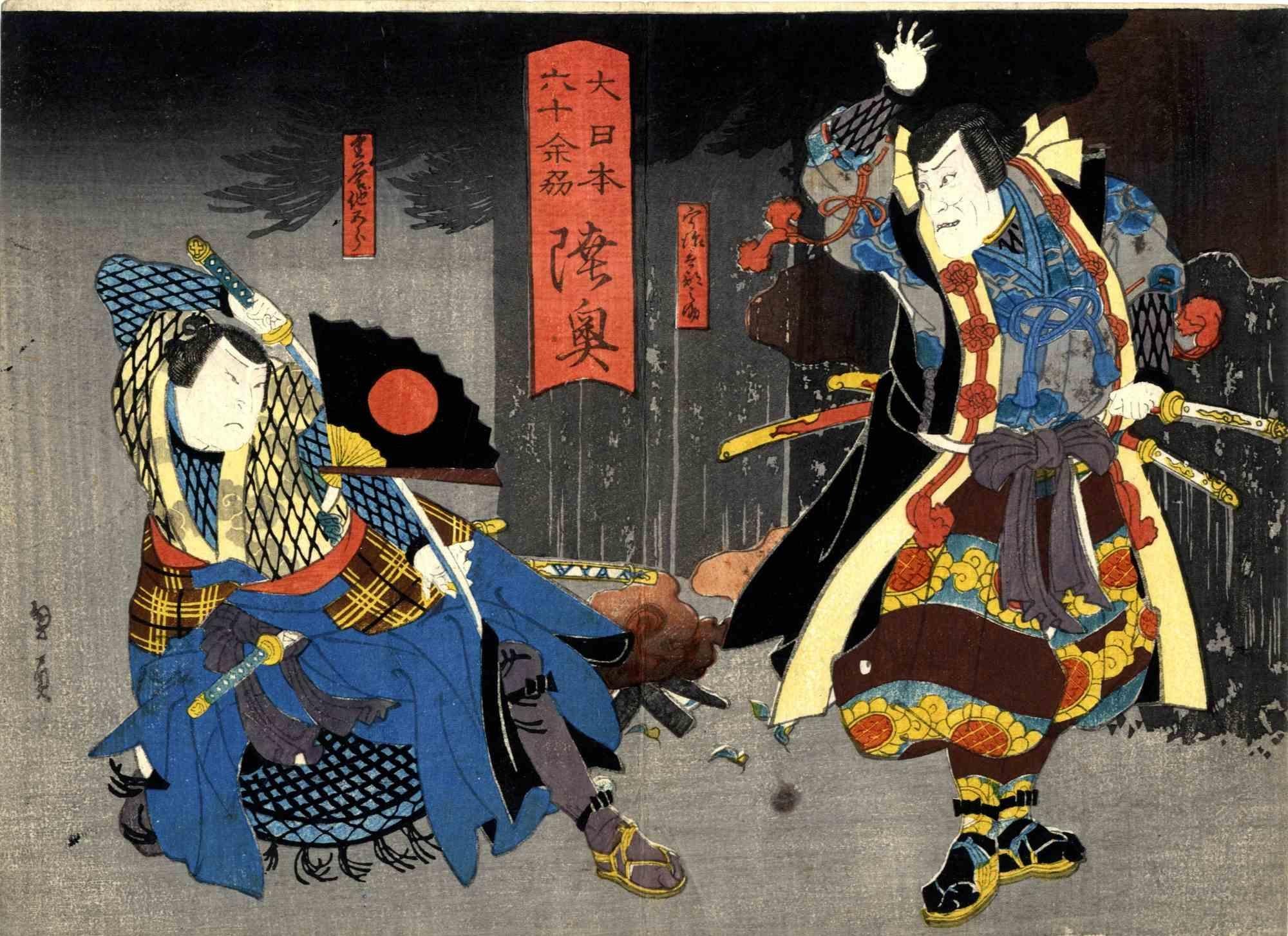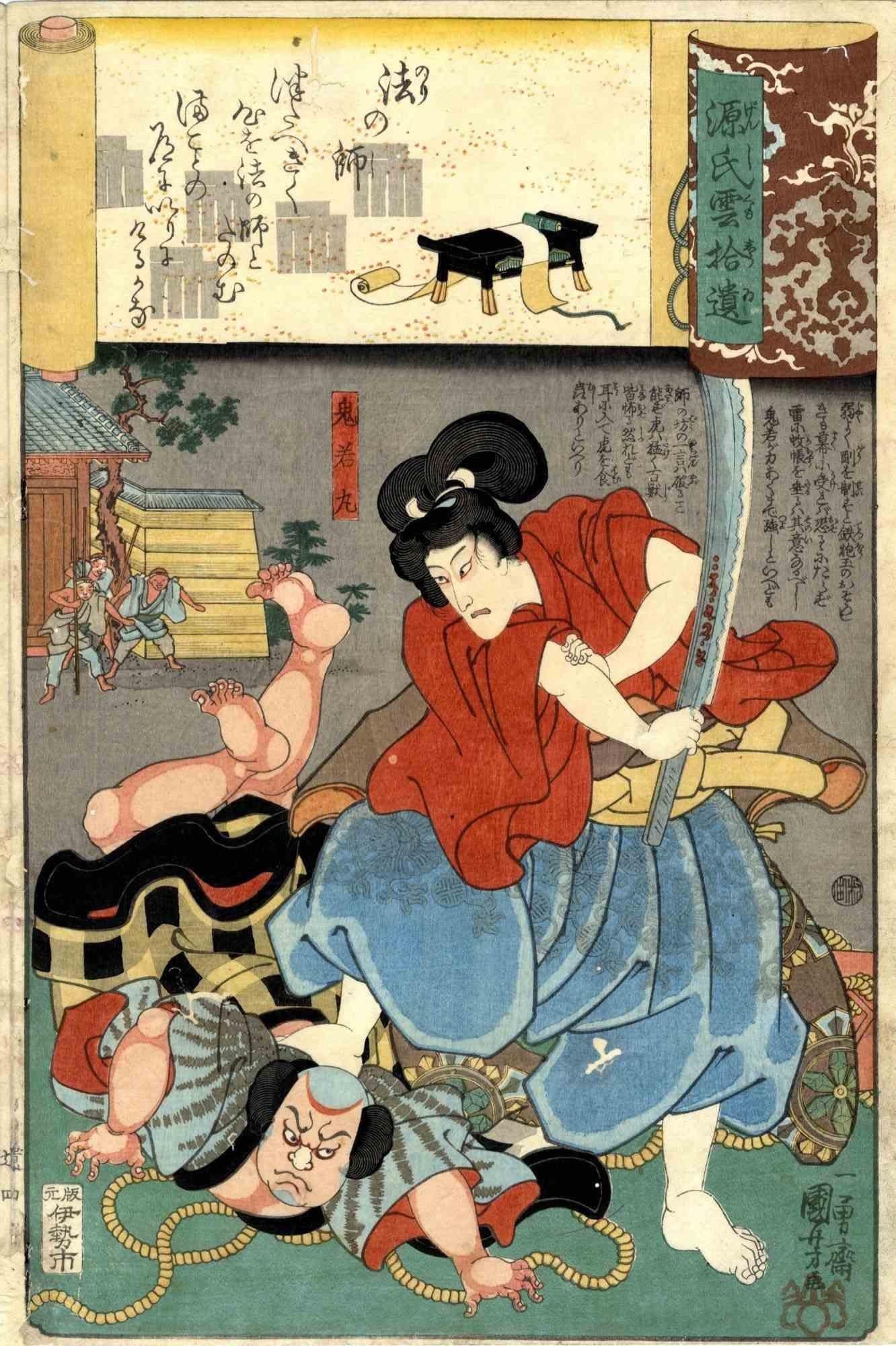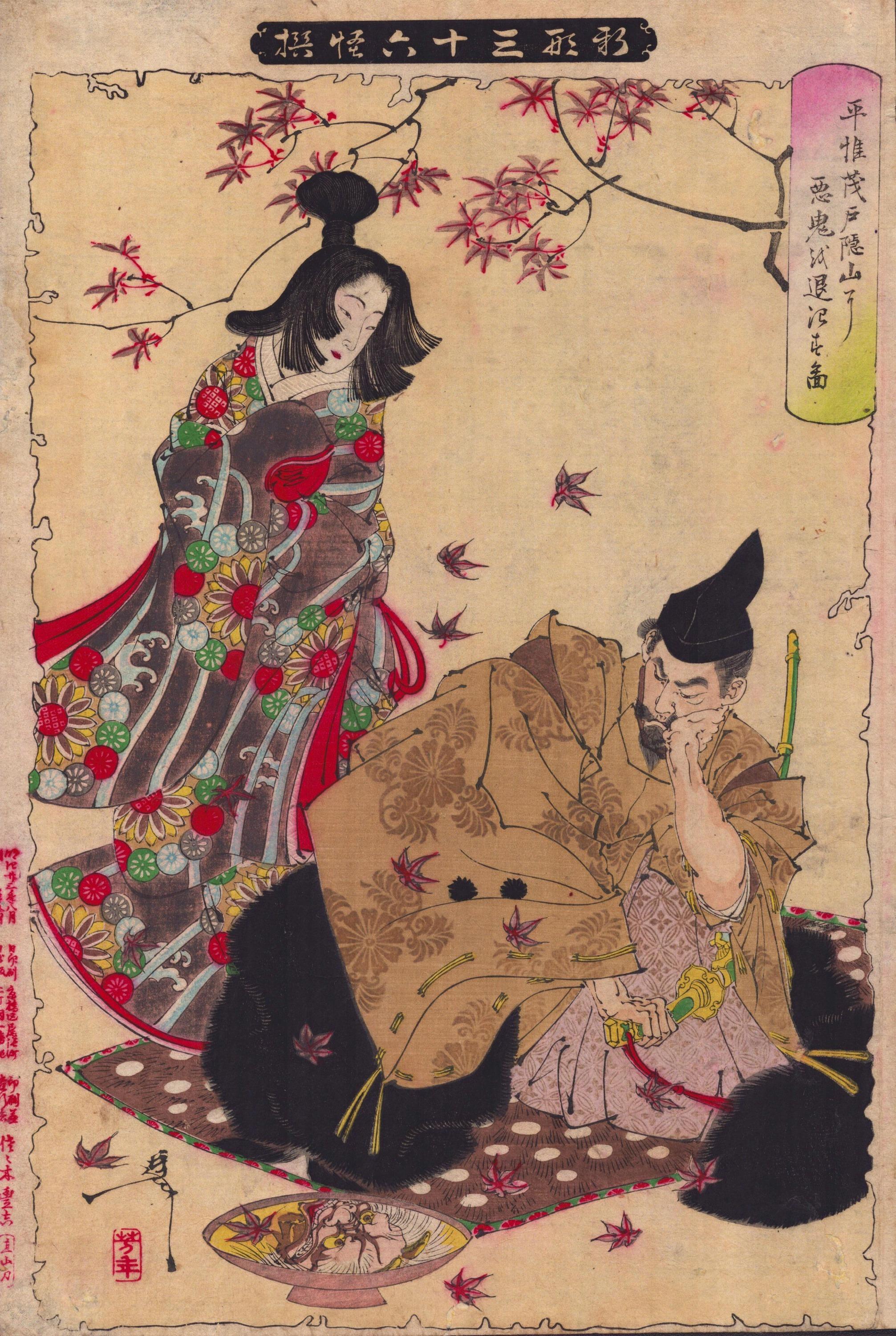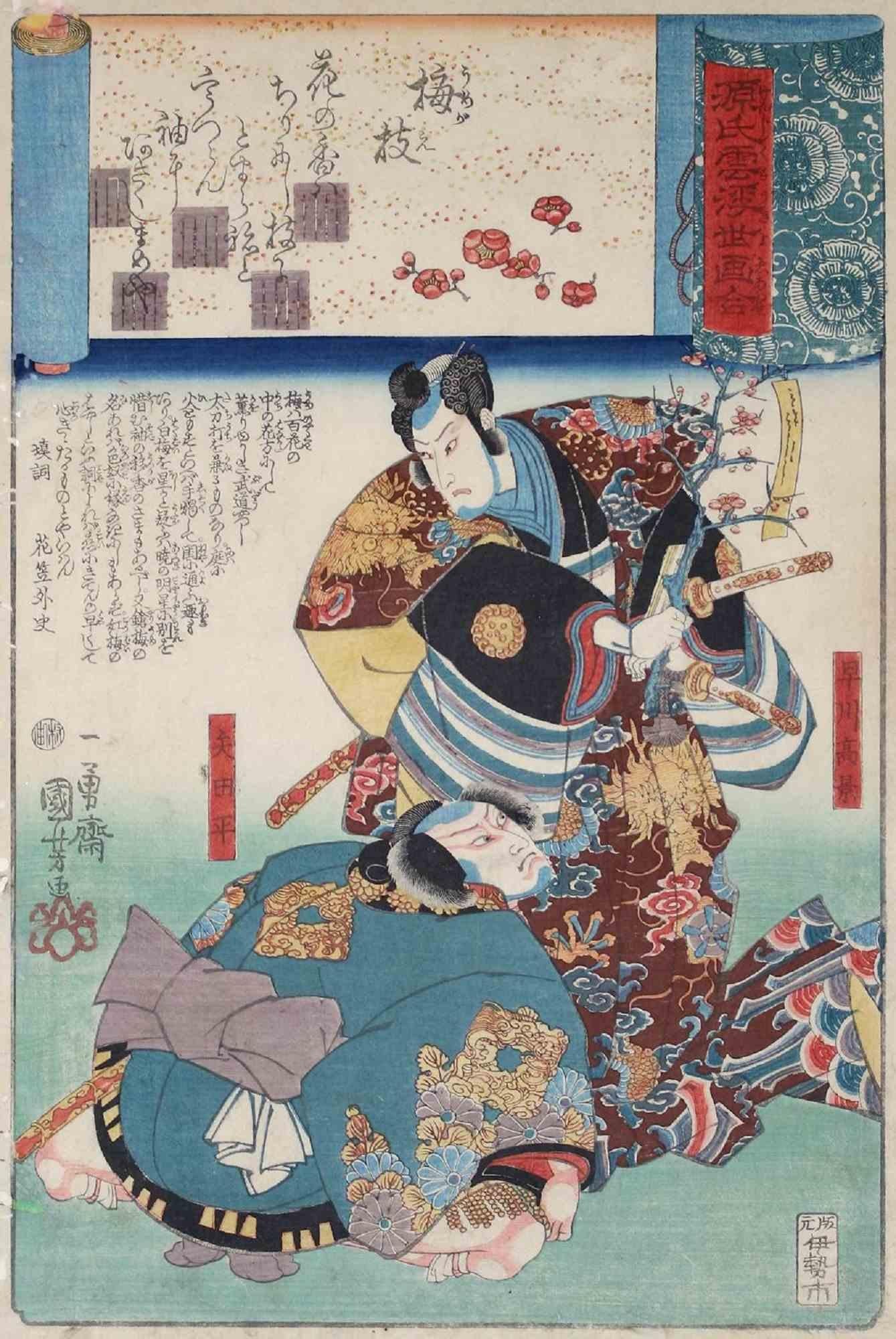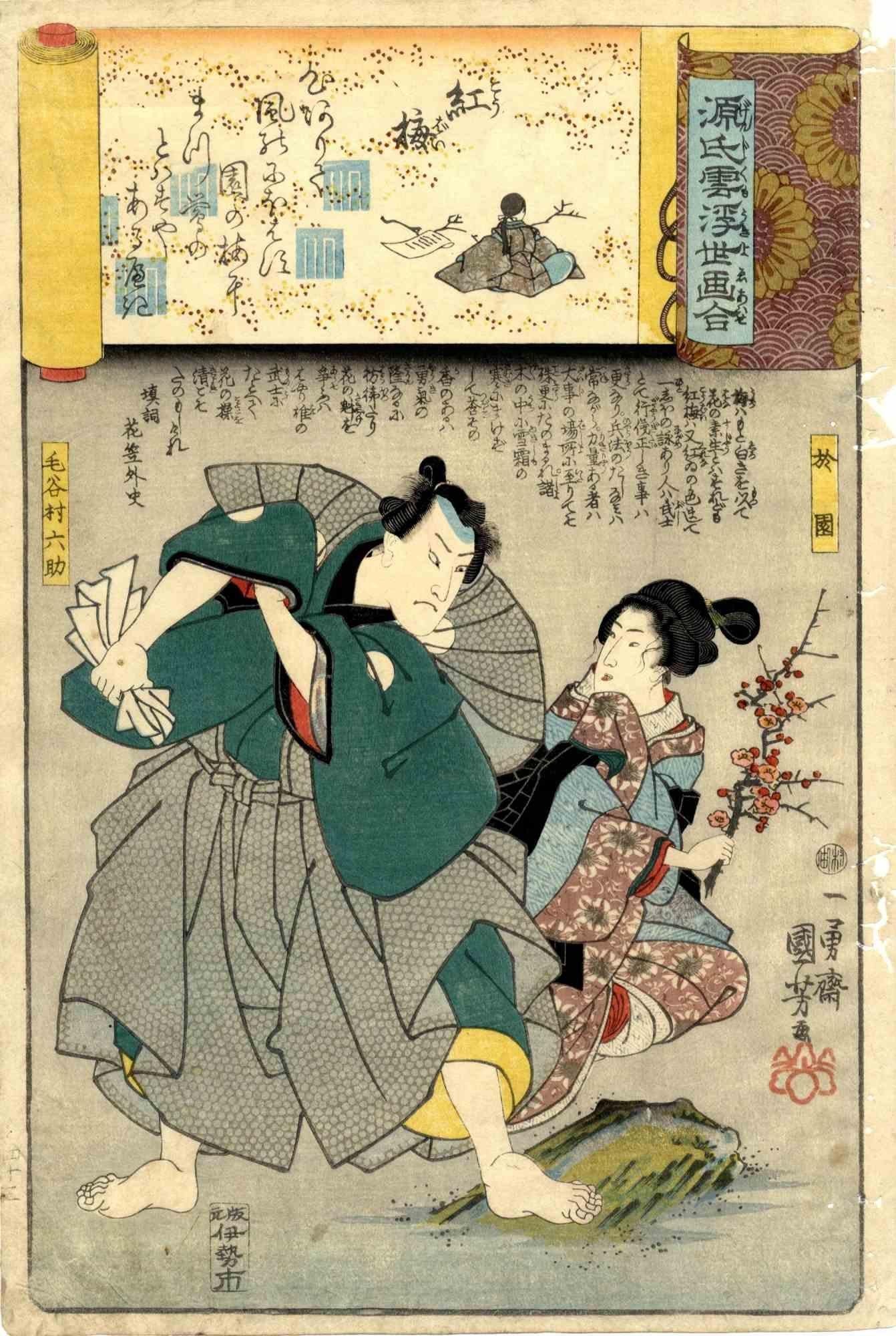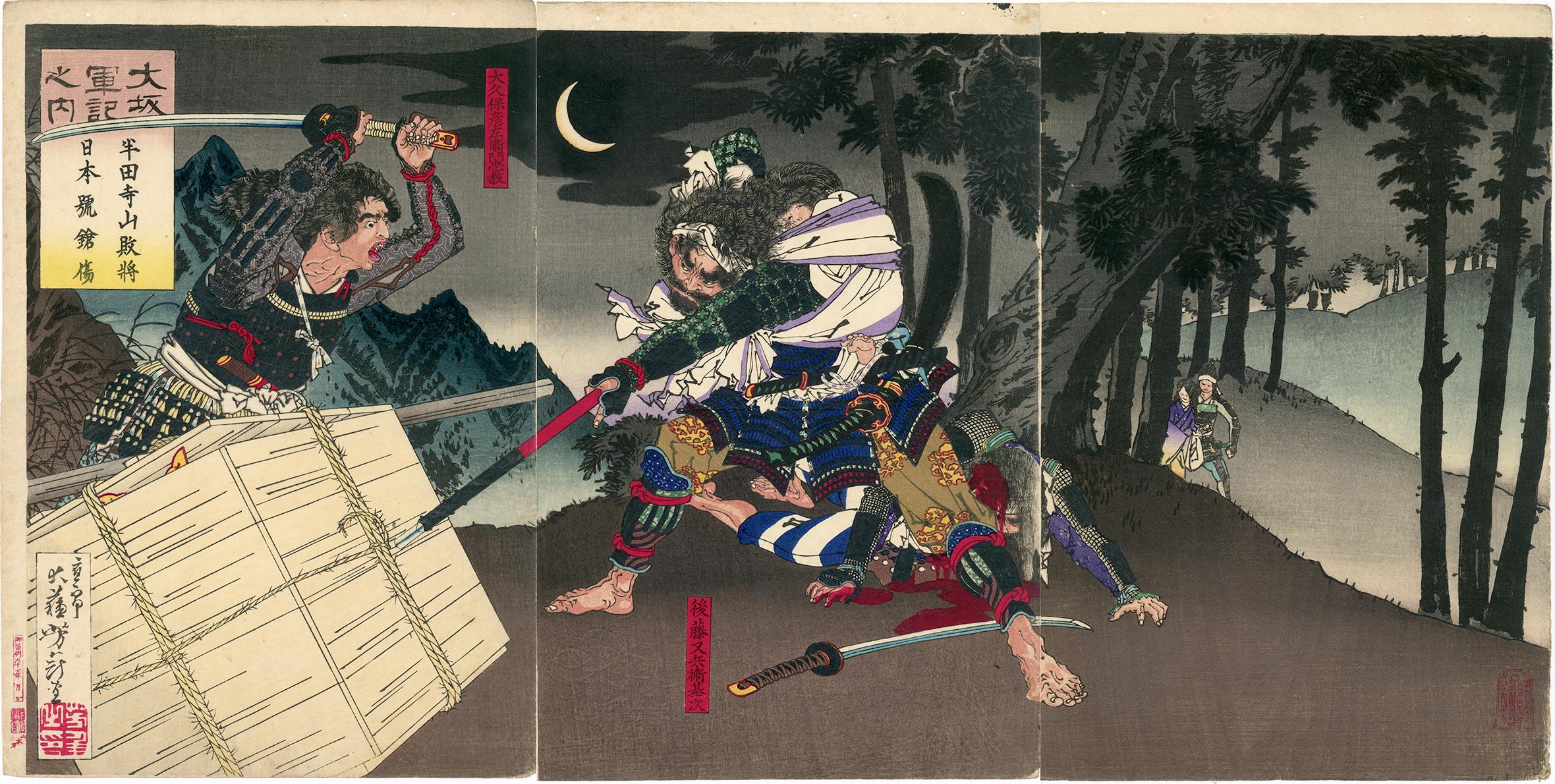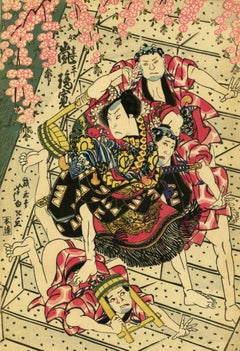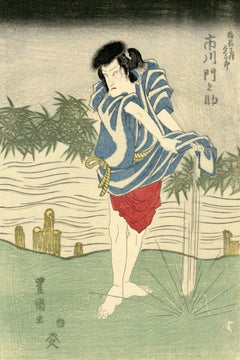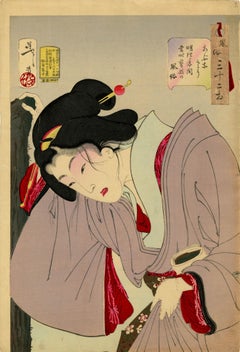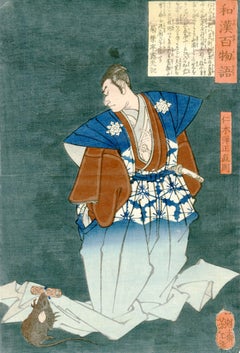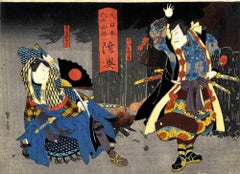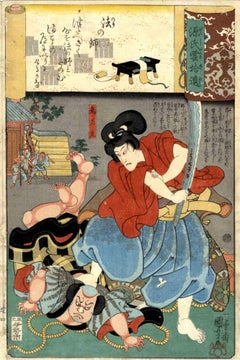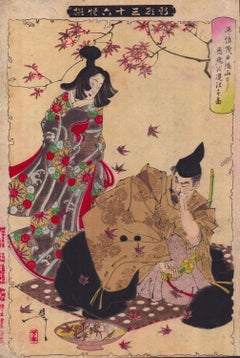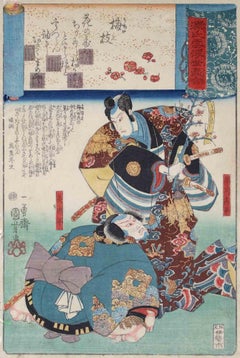Items Similar to Mariko Station, a Mad Caricature (Mariko shukuba no kyoga)
Want more images or videos?
Request additional images or videos from the seller
1 of 8
Kawanabe KyosaiMariko Station, a Mad Caricature (Mariko shukuba no kyoga)1872
1872
$800
£603.28
€697.72
CA$1,122.40
A$1,247.61
CHF 653.97
MX$15,236.37
NOK 8,164.46
SEK 7,681.23
DKK 5,207.59
About the Item
Mariko Station, a Mad Caricature (Mariko shukuba no kyoga)
Color woodcut, 1872
Signed in cartouche lower left corner (see photo)
From the series: "53 Stations by Calligraphy and Painting" (Shoga gojusan eki)
Publisher: Sawamuraya
Condition: excellent color and impression
Image size: 13-1/4 x 9-1/4"
Reference: Kawanabe: Comic Genius (1996), plate 173
Biography of Kawanabe Kyosai (1831-1889)
Courtesy Wikipedia
Living through the Edo period to the Meiji period, Kyōsai witnessed Japan transform itself from a feudal country into a modern state. Born at Koga, he was the son of a samurai. His first shock was at the age of nine when he picked up a human head separated from a corpse in the Kanda river. After working for a short time as a boy with ukiyo-e artist Utagawa Kuniyoshi, he received his formal artistic training in the Kanō school under Maemura Tōwa (前村洞和, ? – 1841), who gave him the nickname "The Painting Demon", but Kyōsai soon abandoned the formal traditions for the greater freedom of the popular school. During the political foment which produced and followed the revolution of 1867, Kyōsai attained a reputation as a caricaturist. His very long painting on makimono (a horizontal type of Japanese handscroll/scroll) "The battle of the farts" may be seen as a caricature of this foment. He was arrested three times and imprisoned by the authorities of the shogunate. Soon after the assumption of effective power by the Emperor, a great congress of painters and men of letters was held at which Kyōsai was present. He again expressed his opinion of the new movement in a caricature, which had a great popular success, but also brought him into the hands of the police, this time of the opposite party.
Kyōsai is considered by many to be the greatest successor of Hokusai (of whom, however, he was not a pupil), as well as the first political caricaturist of Japan. His work mirrored his life in its wild and undisciplined nature, and occasionally reflected his love of drink. Although he did not possess Hokusai's dignity, power or reticence, he compensated with a fantastic exuberance, which always lent interest to his technically excellent draughtsmanship.
He created what is considered to be the first manga magazine in 1874: Eshinbun Nipponchi, with Kanagaki Robun. The magazine was heavily influenced by Japan Punch, founded in 1862 by Charles Wirgman, a British cartoonist. Eshinbun Nipponchi had a very simple style of drawings and did not become popular with many people, and ended after just three issues.
In addition to his caricatures, Kyōsai painted a large number of pictures and sketches, often choosing subjects from the folklore of his country, Nô drama, nature and religion, for example The Temptation of Shaka Niorai or The goddess Kwannon on a dragon (on kakejiku frame). A fine collection of these works is preserved in the British Museum; and there are also good examples in the National Art Library at South Kensington and the Guimet Museum at Paris. The Kawanabe Kyōsai Memorial Museum was established in 1977, located at Warabi, Saitama Prefecture, Japan.
Erwin Bälz wrote in his diary that Kyosai died because of gastric cancer.
A crater on Mercury has been named in his honor.
Bibliography
The most important work about Kyōsai's art and life was written by himself: Kyōsai Gadan (暁斎画談), or "Kyōsai's Treatise on Painting", half autobiography and half painting manual. An important contemporary work concerning the artist is Kawanabe Kyōsai-ō den (河鍋暁斎翁伝), or "Biography of the Old Man Kawanabe Kyōsai", by Iijima Kyoshin (飯島虚心). The work was finished in 1899, but published only in 1984.
Many westerners came to visit Kyōsai, and their memoirs about the artist are valuable. The two important ones, both rare, are:
• Émile Étienne Guimet, Promenades japonaises, Paris, 1880
• Josiah Conder, Paintings and Studies by Kawanabe Kyōsai, Tokyo, 1911. Conder was a serious student of Japanese art; after some initial rejections, he was accepted as Kyōsai's pupil, and accompanied him for ten years until the master's death.
The most updated, and easily available, reference to Kyōsai's life and works in English is:
• Timothy Clark, Demon of painting: the art of Kawanabe Kyōsai, London: Published for the Trustees of the British Museum by the British Museum Press, 1993
About the Seller
5.0
Recognized Seller
These prestigious sellers are industry leaders and represent the highest echelon for item quality and design.
Platinum Seller
Premium sellers with a 4.7+ rating and 24-hour response times
Established in 1978
1stDibs seller since 2013
808 sales on 1stDibs
Typical response time: <1 hour
Associations
International Fine Print Dealers Association
- ShippingRetrieving quote...Shipping from: Akron, OH
- Return Policy
Authenticity Guarantee
In the unlikely event there’s an issue with an item’s authenticity, contact us within 1 year for a full refund. DetailsMoney-Back Guarantee
If your item is not as described, is damaged in transit, or does not arrive, contact us within 7 days for a full refund. Details24-Hour Cancellation
You have a 24-hour grace period in which to reconsider your purchase, with no questions asked.Vetted Professional Sellers
Our world-class sellers must adhere to strict standards for service and quality, maintaining the integrity of our listings.Price-Match Guarantee
If you find that a seller listed the same item for a lower price elsewhere, we’ll match it.Trusted Global Delivery
Our best-in-class carrier network provides specialized shipping options worldwide, including custom delivery.More From This Seller
View AllArashi Rikan II in an Osaka Kabuki Scene
Located in Fairlawn, OH
Arashi Rikan II in an Osaka Kabuki Scene
Color woodcut, c. 1827
Signed middle left (see photo)
Titled upper left (see photo)
Format: oban
Publisher: Honsei
The actor, in character, d...
Category
1820s Other Art Style Figurative Prints
Materials
Woodcut
Inari Kozo Tasaburo- Kabuki
By Utagawa Toyokuni
Located in Fairlawn, OH
Inari Kozo Tasaburo- Kabuki
Color woodcut, c. 1820
Signed: ‘Toyokuni’
Publisher: ‘Yamamoto Heikichi’
Censor: Hama and Magome
Very good impression and color
Sheet/Image size: 15 1/2 x...
Category
1820s Other Art Style Figurative Prints
Materials
Woodcut
Dangerous: The Appearance of a Contemporary Geisha of the Meiji Era
By Taiso Yoshitoshi
Located in Fairlawn, OH
Dangerous: The Appearance of a Contemporary Geisha of the Meiji Era
Color woodcut, 1888
Plate 28 from the series "Thirty-two Aspects of Customs and Manners" (Fuzoku Sanjuniso)
Format...
Category
1880s Figurative Prints
Materials
Woodcut
Nikki Danjo (Naonon)
By Taiso Yoshitoshi
Located in Fairlawn, OH
"One of the main characters of the kabuki play Meiboku Sendai hagi (The Disputed Succession)"
Signed: Ikkaisai Yoshitoshi ga (in gourd shaped cartouche)
Format: oban
Publisher: Da...
Category
1860s Figurative Prints
Materials
Woodcut
The Story of Tamiya Bataro
By Taiso Yoshitoshi
Located in Fairlawn, OH
The Story of Tamiya Bataro
Color woodcut diptych, March 22, 1886
Signed and sealed by the artist (see photo) Yoshitoshi signature, Taiso seal
Series: New selection of eastern brocad...
Category
1880s Figurative Prints
Materials
Woodcut
Kataoka Nizayemon(?)
By Utagawa Kunisada (Toyokuni III)
Located in Fairlawn, OH
Exceptional, brilliant impression and colors from the extremely rare 1st edition
Kataoka Nizayemon(?)
Color woodcut, 1860
From the series: "Contemporary Brocade Mirror Portraits"
Pub...
Category
1860s Portrait Prints
Materials
Woodcut
You May Also Like
Kabukie - The Province of Rokuok - Woodcut by Utagawa Kunikazu - 1862
By Utagawa Kunikazu
Located in Roma, IT
Kabukie - The Province of Rokuoku is an original artwork realized in 1862 by Utagawa Kunikazu (1830 - 1919)
Chuban.
From the series "Dai Nippon rokuju of Rikuoku" (60 provinces of Glorious Japan), The Province of Rokuoku.
Meeting of the two rivals in the forest at night, Tanigoro with sumo apron and fan with the national colours.
Signed: Kunikazu.
Good impression, backed, glued at corners, oxidation, centrefold, a little bit rubbed.
Utagawa Kunikazu (1830 - 1919) was a printmaker from Osaka. He had a famous teacher, the ukiyo-e artist Kunisada Utagawa...
Category
1860s Modern Figurative Prints
Materials
Woodcut
Mushae - Woodcut by Utagawa Kuniyoshi - 1846
By Utagawa Kuniyoshi
Located in Roma, IT
Mushae is an original modern artwork realized by Utagawa Kuniyoshi (1798 – 1861) in the half of the 19th Century.
Original woodcut print rom the se...
Category
1840s Modern Figurative Prints
Materials
Paper, Woodcut
Yoshitoshi: Taira no Koremochi Vanquishing the Demon of Mount Togakushi
By Tsukioka Yoshitoshi
Located in BRUCE, ACT
Tsukioka Yoshitoshi
Taira no Koremochi Vanquishing the Demon of Mount Togakushi
From Series: “New Forms of Thirty-six Ghosts”
「新形三十六怪撰」 「平惟茂戸隠山に悪鬼を退治す図」
C. 1890
Size: Oban
Ex...
Category
1890s Figurative Prints
Materials
Woodcut
$1,302 Sale Price
30% Off
Umegaye. Hayakawa Takakage in... - Woodcut by Utagawa Kuniyoshi - 19th century
By Utagawa Kuniyoshi
Located in Roma, IT
Woodcut print realized by Utagawa Kuniyoshi in 19th century.
Good condition.
Category
Mid-19th Century Modern Figurative Prints
Materials
Woodcut
Kabukie - Woodcut by Utagawa Kuniyoshi - 1850
By Utagawa Kuniyoshi
Located in Roma, IT
Kabukie is an original modern artwork realized by Utagawa Kuniyoshi (1798 – 1861) in the half of the 19th Century.
Original woodcut from the series...
Category
1850s Modern Portrait Prints
Materials
Paper, Woodcut
Ôkubo Hikozaemon Protects the Hidden Shogun Triptych
By Taiso Yoshitoshi
Located in Burbank, CA
“War Chronicles of Osaka” (Osaka gunki no uchi). Okubo Hikozaemon, raising his sword, protects the hidden Tokugawa shogun from the spear of Gorô Matabei Mototsugu in a moonlit fores...
Category
1880s Other Art Style Figurative Prints
Materials
Mulberry Paper, Woodcut
More Ways To Browse
Calligraphy Scroll
Japanese Scroll Landscape Painting
Antique Police
Antique Japanese Calligraphy
Antique Dragon Mirror
Japanese Scroll Framed
English Country Mirror
Goddess Dior
Dior Dragon
Japanese Scroll Kano
Antique Manga
Ellison Hoover On Sale
Frances Palmer
Frances St Clair Miller
Franz Herbelot
Fugi Nakamizo
Gary Soszynski
Gene Pelham
